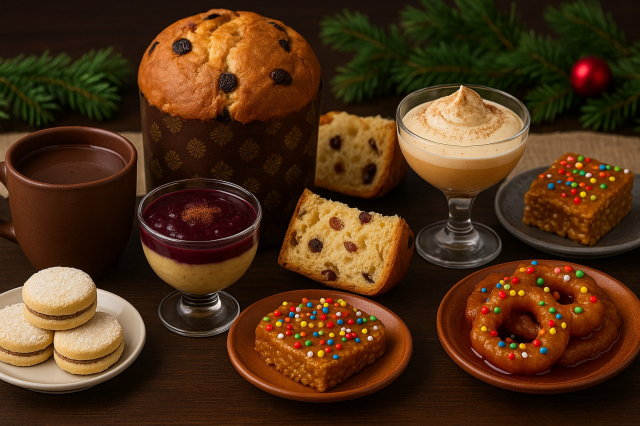In Peru, the end-of-year holidays aren't just celebrated with music, lights, and hugs. They're also experienced through the palate. Peruvian desserts play a special role on Christmas and New Year's tables, combining recipes inherited from grandmothers with modern touches.
From the classic panettone with hot chocolate to the regional sweets of the highlands and jungle, each bite tells a story of family, identity and flavor.
Peruvian panettone: the king of celebrations
No Peruvian December is complete without panettone , that fluffy sponge cake with candied fruits and raisins that is enjoyed accompanied by a good thick hot chocolate .
Although it has Italian origins, panettone has become a national custom, with iconic brands like D'Onofrio or Todinno and artisanal versions in local bakeries.
In many families, it's prepared at home, incorporating local ingredients like candied orange or Amazonian cacao chips. In the south, it's even common to serve it with Andean cheese or butter.
Purple corn pudding and rice pudding: the inseparable duo
Although traditionally associated with the purple month, purple corn pudding and rice pudding are also served in December as a symbol of family unity.
Its blend of flavors—the sweetness of the rice pudding and the acidic touch of the mazamorra made with purple corn—represents the perfect balance between Andean and Creole cuisine.
A touch of cinnamon, cloves, and orange zest makes this duo one of the most recognized and beloved Peruvian desserts.
👉 You can learn more about its origin and symbolism in our article Purple Corn Pudding and Rice Pudding Day .
Christmas nougat with Peruvian flavor
Inspired by the famous Doña Pepa nougat , the Peruvian Christmas nougat adapts this classic recipe to the end-of-year festivities.
It is made with a soft butter dough, honey syrup, chancaca (unrefined cane sugar) and anise, decorated with colorful sprinkles that evoke the joy of the season.
In many homes, this dessert replaces imported sweets and is shared as a symbol of prosperity.
Sighs and Lima delicacies to close out the year
Suspiro a la limeña , a source of pride for Peruvian cuisine, is another star of the celebrations. Its base of manjar blanco (a type of milk caramel) with Italian meringue and port wine transforms any Christmas dinner into a feast.
It is served cold, in small glasses, and is often accompanied by a sweet wine or a glass of champagne when toasting the New Year.
Other traditional Lima desserts that are usually prepared in December are alfajor , champús and picarones , the latter being very common at fairs and family gatherings.
Regional sweets that sweeten Peru
Peru has a variety of regional desserts that also shine on festive tables:
| Region | Typical dessert | Main ingredient |
|---|---|---|
| Arequipa | Frozen cheese | Milk, cinnamon and coconut |
| Cusco | Api and fritters | Purple corn and flour |
| Piura | Piura-style custard | Goat's milk and chancaca |
| Junín | Milk soup | Bread, milk and sugar |
| San Martín | Camu camu sweet | Amazonian fruit and sugar |
These desserts, although less well-known nationally, reflect the culinary creativity of each region and can be excellent alternatives for those who want to innovate at parties without losing the Peruvian touch.
Peruvian innovations for a sweet and modern end of the year
New generations are reinterpreting traditional desserts with healthy ingredients and modern presentations.
Popular examples include:
Quinoa or kiwicha panettone.
Sugar-free purple corn pudding.
Lucuma cheesecake.
Brownies with cocoa from Tarapoto.
These fusions keep tradition alive, adapting to new trends without losing the Peruvian essence.
The cultural value of sharing a dessert
Beyond their flavor, Peruvian end-of-year desserts represent unity, memories, and hope. Preparing them as a family is a way to keep traditions alive and pass them on to new generations.
In every home, a sweet aroma of cinnamon, cloves, and condensed milk announces that the holidays have arrived.
Recommendations for enjoying a Peruvian-flavored New Year's Eve
Prepare desserts at home with local products such as cocoa, purple corn and Andean fruits.
Share family recipes at school gatherings or fairs.
Support regional producers by buying panettone or artisanal sweets.
Create healthy versions for children and the elderly without losing the original flavor.
👉 We also recommend visiting our article Regional Gastronomy of Peru to discover more typical flavors by department.
Sweetness that unites generations
The end-of-year festivities in Peru are a blend of faith, joy, and tradition. And desserts, in all their forms, are the perfect link between the past and the present.
Whether it's with a panettone at dawn or with a purple corn pudding after dinner, every Peruvian sweet reminds us that celebrating is also about sharing.
